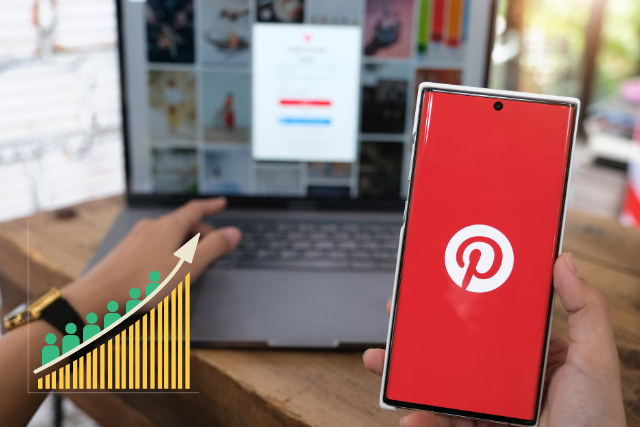With over 400 million active users, Pinterest is more than just a platform for recipes and DIY projects; it’s a powerful tool for driving traffic to online stores.
Businesses leveraging Pinterest have reported a two-fold increase in sales, demonstrating the platform’s potential to boost visibility and customer engagement significantly. This article will guide you through harnessing Pinterest’s potential to grow your online store’s traffic effectively.
Understanding the Potential of Pinterest
Pinterest is unique compared to other social media platforms. Instead of simply scrolling through content, users visit Pinterest with the intent of finding inspiration, ideas, and products. This user behavior makes Pinterest an ideal platform for showcasing your online store’s offerings. Unlike other social platforms where users might stumble upon your products by chance, Pinterest users are actively seeking solutions, making them more likely to engage with your content and make a purchase.
Statistics reveal that 85% of Pinners make purchasing decisions based on content they find on Pinterest. This means that if your products are well-represented on the platform, they have a high chance of being discovered by potential buyers. Furthermore, Pinterest functions as a visual search engine. Its intuitive search algorithm effectively matches user queries with relevant pins, making it crucial to use relevant keywords in your pin descriptions.
Why Visual Appeal Matters
Pinterest’s visual nature allows your store to shine. High-quality images and captivating designs are essential to attract more clicks and engagement. Think of your pins as mini advertisements; the better they look, the more likely they are to draw attention. Research shows that visually appealing pins, especially those with a strong color scheme and clear imagery, tend to perform better in terms of engagement.
Moreover, Pinterest offers features like Rich Pins that provide more information directly on the pin, such as product details, availability, and pricing. Rich Pins can enhance your customers’ shopping experience by giving them all the information they need at a glance, which can significantly increase the likelihood of a purchase.
Building a Solid Pinterest Profile
Your Pinterest profile is the foundation of your brand’s presence on the platform. A well-constructed profile helps establish credibility and makes it easier for potential customers to find your store. Here’s how to set up your profile for success:
Profile Picture and Bio
Start with a recognizable profile picture—preferably your business logo or a professional image that reflects your brand identity. Consistency in visual branding across your profile builds trust and recognition among users.
Next, write a compelling bio that clearly describes what your store offers. Incorporate keywords related to your niche to improve your Pinterest SEO. For example, if you sell eco-friendly fashion, include phrases like “sustainable clothing” or “eco-friendly fashion” in your bio. This helps users find your store when searching for those terms.
Organizing Your Boards
Organize your Pinterest boards in a way that makes it easy for users to navigate through your products. Consider creating specific boards for different product categories such as:
- Best Selling Products
- Seasonal Collections
- Customer Favorites
Well-organized boards make it easy for users to find what they’re looking for quickly, improving their overall experience on your profile. Regularly updating your boards with new pins keeps your content fresh and encourages repeat visits.
Verifying Your Website
Verify your website with Pinterest to gain access to valuable analytics tools. This not only gives you insights into your audience’s behavior and which pins drive the most traffic, but it also adds a layer of credibility to your profile. Verified accounts are often perceived as more trustworthy, which can help attract more followers and potential customers.
Developing an Effective Pinning Strategy
An effective pinning strategy is key to driving traffic to your online store. Here’s how to develop a strategy that works:
Understanding Your Audience
Start by identifying your target audience and understanding their preferences. Tailor your content to match their interests, and use high-quality images and engaging descriptions to capture their attention. Consistently posting content that resonates with your audience will encourage them to save your pins, further increasing your reach.
Consistency is Key
Aim to pin content daily rather than sporadically. Regular activity keeps your profile active and visible in followers’ feeds. Utilize Pinterest’s scheduling tools to plan your pins in advance, ensuring a steady flow of content even when you’re not actively pinning. This consistency can lead to more engagement and, ultimately, more traffic to your store.
Diversifying Your Content
Include a mix of your own product pins and repins from other relevant content. This approach keeps your audience engaged and coming back for more. Think about creating pins for:
- New product releases
- Weekly tips and tricks related to your niche
- Customer reviews and testimonials
By diversifying your content, you cater to different segments of your audience and keep your profile interesting.
Collaborate with Influencers
Collaborating with influencers in your industry can help extend your reach to a broader audience. Look for popular Pinterest users who align with your brand’s values and aesthetics. Influencer collaborations can significantly boost your visibility and attract new customers to your online store.
Using Pinterest Analytics
Pinterest Analytics is an invaluable tool for tracking the performance of your pins. Analyze which pins drive the most traffic and engagement, and adjust your strategy accordingly. By continuously refining your approach based on data, you can optimize your pinning strategy to achieve better results over time.
Leveraging Shopping Ads and Promoted Pins
Pinterest offers several advertising options that can help increase your store’s visibility, including shopping ads and promoted pins.
Shopping Ads
Shopping ads allow users to shop directly from your pins, creating a seamless shopping experience. These ads include product details, prices, and direct links to your online store, which can significantly increase conversion rates. To make the most of shopping ads, ensure your product images are high-quality and your descriptions are keyword-rich.
Promoted Pins
Promoted pins function similarly to regular pins but with enhanced reach. They appear in users’ feeds, searches, and category feeds, making them more visible to potential customers. To get started with promoted pins, choose high-performing content with compelling images and descriptions. Promoted pins help your content reach a broader audience, increasing the likelihood of driving traffic to your store.
Setting a Budget
When using promoted content, it’s crucial to set a budget. Pinterest offers flexible budgeting options, allowing you to choose between daily or lifetime budgets for your campaigns. Monitoring your spending and adjusting as needed ensures you get the most value out of your ads.
Targeting Options
Pinterest’s targeting options are versatile, allowing you to target users based on interests, keywords, and demographics. This ensures your pins reach the right audience, increasing the effectiveness of your ads. For example:
- Interest targeting (e.g., fashion enthusiasts)
- Keyword targeting (e.g., “handmade jewelry”)
- Demographic targeting (e.g., age, location)
Precise targeting options help you reach users most likely to engage with your content and visit your store.
Tracking Conversions
Use the Pinterest Tag, a piece of code you add to your website, to track conversions. This helps you measure the actions users take after viewing your ads, providing valuable data that can guide future advertising strategies. Track metrics like click-through rates and conversions to determine the success of your campaigns.
Analyzing Ad Performance
Regularly analyze the performance of your ads using Pinterest Analytics. Look at metrics such as engagement rates and return on investment (ROI) to refine your strategy and get better results over time. Be prepared to tweak and optimize your campaigns based on these insights.
Harnessing the Power of SEO on Pinterest
To maximize your visibility on Pinterest, it’s essential to leverage SEO techniques. Here’s how to optimize your content for Pinterest’s search algorithm:
Focus on Keywords
Keywords are crucial for making your pins discoverable in search results. Use relevant keywords in your pin titles, descriptions, and board names to help Pinterest’s algorithm match your content with user searches. Aim for keywords that fit your niche and audience to ensure your pins reach the right users.
Writing Rich Descriptions
Rich descriptions can improve your SEO on Pinterest. Write detailed descriptions that include your primary keywords and use engaging language to encourage users to click through to your store. Descriptions should be informative but concise, and adding relevant hashtags can further increase your pins’ visibility.
Organizing Boards Strategically
Organize your boards strategically to optimize your profile’s SEO. Create boards specific to different product categories, such as:
- Eco-Friendly Products
- Summer Fashion
- DIY Home Décor
This not only makes it easy for users to find what they’re looking for but also signals to Pinterest what your content is about, improving your chances of appearing in relevant searches.
Use High-Quality Images
High-quality images are key to capturing attention on Pinterest. Images with text overlays perform particularly well, providing additional context that can encourage engagement. Ensure your images are well-lit and visually appealing to maximize their impact.
Utilizing Pinterest’s Guided Search
Pinterest’s guided search feature provides keyword suggestions based on user searches. Incorporate these suggestions into your content to increase visibility and stay updated on trending topics and keywords to keep your content relevant.
Monitoring SEO Performance
Regularly monitor your SEO performance using Pinterest Analytics. Look at metrics like impressions, clicks, and saves to assess the effectiveness of your keywords and descriptions. Continuously refine your strategy based on this data to maintain strong SEO performance on the platform.
The Role of Pinterest Analytics in Driving Store Traffic
Pinterest Analytics is a powerful tool for understanding how your pins perform and driving traffic to your online store. It provides insights into which pins are most effective, allowing you to tailor your strategy accordingly.
Understanding User Engagement
Analytics reveal valuable information about user engagement, including clicks, saves, and comments. High engagement indicates that users find your content valuable and interesting, which can inform your content creation moving forward.
Tracking Conversions and ROI
Pinterest Analytics also tracks conversions, showing how many users make purchases after interacting with your pins. This data is crucial for assessing the ROI of your Pinterest strategy and allocating resources effectively to boost sales.
Analyzing Demographics
Understanding your audience demographics helps refine your marketing strategy. For instance, if most of your users are young adults, you might focus on promoting trendy products. If a significant portion is from a specific region, consider creating region-specific content.
Continuous Improvement
Regularly reviewing your Pinterest Analytics enables continuous improvement. By tweaking your pin designs, descriptions, and posting times based on data, you can optimize your approach for better results over time. Experimenting and adapting are key to sustaining growth in online store traffic.
Tips for Sustaining and Growing Your Pinterest-Driven Traffic
To maintain and grow your Pinterest-driven traffic, consider these strategies:
Consistent Pinning
Consistency is vital for maintaining an active presence on Pinterest. Aim to pin regularly, ideally daily, to keep your profile visible and engage your audience. Tools like Tailwind can help schedule your pins and maintain consistency even during busy periods.
Engaging with Your Audience
Engage with your audience to build a loyal community around your brand. Respond promptly to comments and messages, and create interactive pins, such as polls and quizzes, to encourage engagement. A responsive presence helps build trust and fosters repeat visits.
Collaborating with Other Pinners
Collaborations with other pinners and group boards can help extend your reach. Consider co-hosting Pinterest contests with influencers or joining group boards related to your niche. These collaborations can drive significant traffic to your store and introduce your products to new audiences.
Tracking Performance Regularly
Regularly monitor your performance using Pinterest Analytics to refine your strategy. Keep an eye on metrics like impressions, clicks, and saves, and adjust your approach based on what works best. Regular analysis ensures you stay on the right track for sustained growth.
Focusing on High-Quality Content
High-quality, visually appealing content is key to sustaining Pinterest-driven traffic. Invest in professional-quality images and compelling descriptions to attract more clicks and repins. Incorporate seasonal and trending topics to keep your content fresh and relevant.
Diversifying Your Content
Diversify your pinning strategy to keep your audience engaged. Don’t just focus on promoting your products; share helpful tips, tutorials, and user-generated content to make your profile a rich resource for your audience. This approach attracts a wider range of users and keeps your followers interested.
Frequently Asked Questions
1. What types of images work best on Pinterest?
High-quality, vertical images work best on Pinterest as they take up more screen space and grab user attention. Bright colors, clean backgrounds, and well-lit photos enhance engagement. Adding text overlays provides context at a glance and attracts more clicks.
2. How do promoted pins differ from regular pins?
Promoted pins are ads that appear in users’ feeds like regular pins but with greater reach. They are targeted based on user interests, activities, and demographics, making them more effective for reaching potential buyers. Unlike regular pins, you pay to increase their visibility.
3. How often should I pin new content?
Consistent pinning is key for maintaining an active presence on Pinterest. Aim to pin daily or several times a week to keep your audience engaged and increase your chances of being discovered by new users. Scheduling tools can help maintain a consistent posting schedule.
4. Can I use Pinterest Analytics without a business account?
No, Pinterest Analytics is only available for business accounts. Converting your personal account into a business account provides access to valuable data about user engagement and content performance, essential for optimizing your Pinterest marketing efforts.
5. What are Rich Pins and how do they benefit my store?
Rich Pins provide extra details directly on the pin, such as pricing and availability. They sync information from your website to ensure all details remain current, providing users with a seamless shopping experience and increasing the likelihood of a purchase.
6. How can I improve my SEO on Pinterest?
To improve your SEO on Pinterest, focus on using relevant keywords in your pin titles, descriptions, and board names. Write rich descriptions, organize your boards strategically, and use high-quality images to capture attention. Regularly monitor your performance with Pinterest Analytics to refine your SEO strategy.
Conclusion
Using Pinterest to drive traffic to your online store is a powerful strategy that combines creativity, data analysis, and effective marketing techniques. By creating visually appealing pins, utilizing ads, leveraging SEO, and engaging with your audience, you can significantly increase your store’s visibility and drive traffic. Regularly reviewing analytics and adapting your strategy based on insights will help you achieve sustained growth. With consistent effort and a strategic approach, Pinterest can become a cornerstone of your online marketing strategy.







